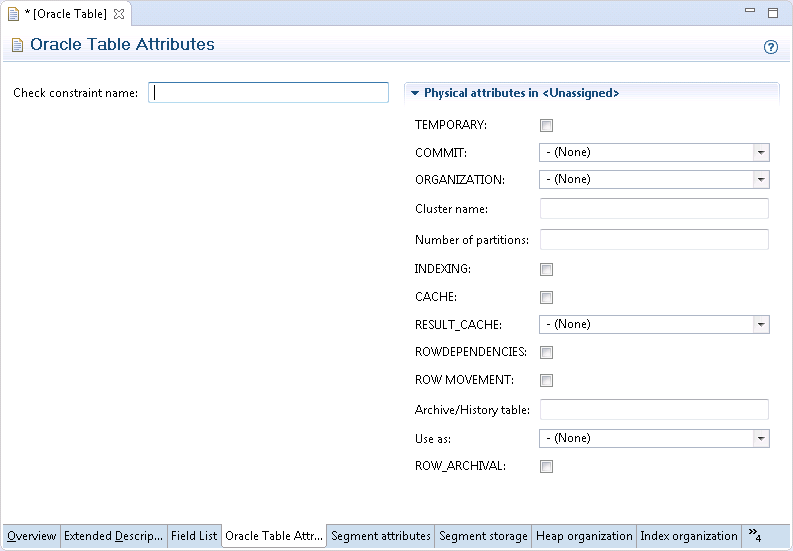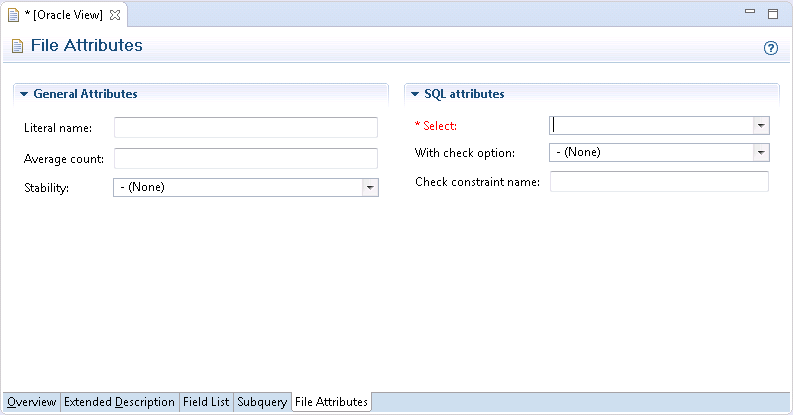Oracle tables and views can be documented in Predict with file objects
of type OT and OV respectively. These file objects can be used to generate DDMs
or CREATE TABLE/VIEW statements.
This document covers the following topics:
The following naming conventions apply for Oracle objects (Files of type OT and OV)
IDs must be entered in upper case. If the Predict parameter General Defaults > Miscellaneous > Upper/lower case / Object ID is set to L and you try and enter a file ID containing lower case letters, an error message is given.
See also section Defaults in the Predict Administration documentation.
Table/View names for Oracle objects can have up to 30 characters.
A fully qualified ID (Creator + Hyphen + Table/View name) must not exceed 32 characters.
IDs containing special characters must be enclosed in double quotes, for example:
"USR1"-"FIL£ABC"
See overview of permitted characters in Naming Conventions.

Note:
Parameters not listed below are described in other sections of
this documentation: Parameters common to all object types, for example Keys,
are described under Global
Attributes. Parameters common to all file types, for
example Literal name, are described under
Common File
Attributes. See also
Common
Parameters for SQL File Types.
| Parameters | ||
|---|---|---|
| TEMPORARY | Y | Global temporary table. |
| N | Not temporary. | |
| ORGANIZATION | Specify how the table is organized. | |
| H | Heap. | |
| I | Indexed. | |
| C | Clustered. | |
| Cluster name | If a cluster name is
entered here, the clause CLUSTER
name is generated in the
CREATE TABLE statement. The table is to be included
in the specified cluster.
|
|
| Number of partitions | The number of partitions of the table. | |
| CACHE | Y | Yes. |
| N | No. | |
| ROWDEPENDENCIES | Y | Yes. |
| N | No. | |
| Archive/History table usage as | Name of the history or archive table linked to the Oracle table. If this option is selected, the following values can be set for "usage as": | |
| A | Archive table. | |
| H | History table. | |
| blank | Not specified. This is the default. | |
| COMMIT | D | Delete. |
| P | Preserve. | |
| blank | Not specified. This is the default. | |
| INDEXING | Specify whether or not this table is indexed. | |
| Y | Yes. Table is indexed. | |
| N | No. Table is not indexed. This is the default. | |
| RESULT_CACHE | Specify whether query results are stored in the result cache. | |
| D | Default. | |
| F | Force. | |
| blank | Not specified. This is the default. | |
| ROW MOVEMENT | Y | Yes. |
| N | No. | |
| ROW_ARCHIVAL | Y | Yes. |
| N | No. | |
| Segment attributes | ||
| PCTFREE |
If an integer from 1 - 99 is specified here, the clause
|
|
| PCTUSED |
If an integer from 1 - 99 is specified here, the clause
|
|
| INITRANS |
If a value from 1 - 255 is entered here, the clause
|
|
| Tablespace | If a tablespace name is
entered here, the clause TABLESPACE name is
generated in the CREATE TABLE statement. This name
represents the tablespace in which the table will be created.
|
|
| LOGGING | Specify whether or not to
use the LOGGING clause in a CREATE
TABLE or ALTER TABLE statement.
|
|
| Y | Yes. | |
| N | No. | |
| F | File system like. | |
| blank | Not specified. This is the default. | |
| Segment storage | ||
If specified, the values
below are used in the STORAGE clause generated with
the CREATE TABLE statement. All of the values below
must be specified as integers.
|
||
| INITIAL | The size of the first extent allocated when the object is created - the original amount of space allocated to the object. A value for Unit has to be applied in addition: | |
| K | Kilobyte. | |
| M | Megabyte. | |
| G | Gigabyte. | |
| T | Terabyte. | |
| P | Petabyte. | |
| E | Exabyte. | |
| NEXT | The size of every subsequent extent to be allocated. A value for Unit has to be applied in addition. Possible values for Unit are described under INITIAL. | |
| MAXSIZE | The MAXSIZE
clause lets you specify the maximum size of the storage element.
|
|
| OPTIMAL | Specifies an optimal size in bytes for a rollback segment. | |
| MINEXTENTS | The total number of extents to be allocated when the segment is created. | |
| MAXEXTENTS | The total number of extents, including the first, which can ever be allocated. | |
| PCTINCREASE | The percent by which each NEXT extent will grow over the last extent allocated. | |
| FREELISTS | The number of process free lists used to administer the free data blocks. | |
| FREELISTS GROUPS | Magnitude of the set of free lists. | |
| BUFFERPOOL | Determines the configuration of the buffer cache. | |
| D | Default | |
| K | Keep | |
| R | Recycle | |
| blank | not specified | |
| FLASH_CACHE | Defines the configuration of a second tier of buffer cache on flash disks. | |
| D | Default | |
| K | Keep | |
| N | None | |
| blank | not specified | |
| Heap organization | ||
| Table compression | Y | Yes. |
| B | Basic. | |
| A | Advanced. | |
| QL | Query low. | |
| QH | Query high. | |
| Q1 | Query low locking. | |
| Q2 | Query high locking. | |
| AL | Archive low. | |
| AH | Archive high. | |
| A1 | Archive low locking. | |
| A2 | Archive high locking. | |
| NL | No row level locking. | |
| N | No. | |
| blank | Not specified. This is the default. | |
| Index organization | ||
| MAPPING TABLE | Y | Yes. |
| N | No. | |
| PCTTHRESHOLD | Maximum size of the portion of the row that is stored in the index block, as a percentage of block size. Must be in the range of 1 to 50. | |
| COMPRESS | Activate index compression for index-organized tables. | |
| Y | Yes. | |
| N | No. | |
| blank | Not specified. This is the default. | |
| Compress length | Specify the compression length. | |
| Index overflow | ||
| Refer to the descriptions given in Segment attributes above. | ||
| Index overflow storage | ||
| Refer to the descriptions given in Segment storage above. | ||
Refer to your Oracle documentation for more information on these Oracle-specific parameters.

Note:
Parameters not listed below are described in other sections of
this documentation: Parameters common to all object types, for example Keys,
are described under Global
Attributes. Parameters common to all file types, for
example Literal name, are described under
Common File
Attributes. See also
Common
Parameters for SQL File Types.
| Parameters | |
|---|---|
| Check constraint name | Name of check option used if parameter With check option is set. See SQL Attributes. |